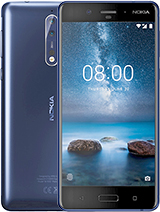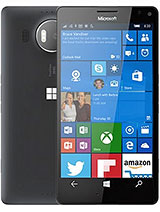Compare
Specifications
Nokia 8 |
Microsoft Lumia 950 XL |
|
|
Full
Differences
Change compare mode
|

|

|
Nokia 8 |
Microsoft Lumia 950 XL |
| Network | ||
|---|---|---|
| Technology | GSM / HSPA / LTE | GSM / HSPA / LTE |
| 2G bands | GSM 850 / 900 / 1800 / 1900 - SIM 1 & SIM 2 (dual-SIM model only) | GSM 850 / 900 / 1800 / 1900 |
| 3G Network | HSDPA 850 / 900 / 1900 / 2100 | HSDPA 850 / 900 / 1700(AWS) / 1900 / 2100 |
| 4G Network | 1, 2, 3, 4, 5, 7, 8, 20, 28, 38, 39, 40, 41 | 1, 2, 3, 4, 5, 7, 8, 12, 20, 28, 38, 40 - EMEA |
| 1, 2, 3, 4, 5, 7, 8, 12, 17, 20, 28, 38, 40, 41 - USA | ||
| Speed | HSPA 42.2/5.76 Mbps, LTE (3CA) Cat9 450/50 Mbps | HSPA 42.2/5.76 Mbps, LTE Cat6 300/50 Mbps |
| Launch | ||
|---|---|---|
| Announced | 2017, August 16 | 2015, October. Released 2015, November |
| Status | Available. Released 2017, September 07 | Discontinued |
| Body | ||
|---|---|---|
| Dimensions | 151.5 x 73.7 x 7.9 mm (5.96 x 2.90 x 0.31 in) | 151.9 x 78.4 x 8.1 mm (5.98 x 3.09 x 0.32 in) |
| Weight | 160 g (5.64 oz) | 165 g (5.82 oz) |
| Build | Glass front (Gorilla Glass 5), aluminum back, aluminum frame (6000 series) | |
| SIM | Single SIM (Nano-SIM) or Hybrid Dual SIM (Nano-SIM, dual stand-by) | Nano-SIM |
| IP54, dust and splash resistant | ||
| Display | ||
|---|---|---|
| Type | IPS LCD | AMOLED |
| Size | 5.3 inches, 77.4 cm2 (~69.4% screen-to-body ratio) | 5.7 inches, 88.5 cm2 (~74.3% screen-to-body ratio) |
| Resolution | 1440 x 2560 pixels, 16:9 ratio (~554 ppi density) | 1440 x 2560 pixels, 16:9 ratio (~518 ppi density) |
| Protection | Corning Gorilla Glass 5 | Corning Gorilla Glass 4 |
| Always-on display | ClearBlack display | |
| Platform | ||
|---|---|---|
| OS | Android 7.1.1 (Nougat), upgradable to Android 9.0 (Pie) | Microsoft Windows 10 |
| Chipset | Qualcomm MSM8998 Snapdragon 835 (10 nm) | Qualcomm MSM8994 Snapdragon 810 (20 nm) |
| CPU | Octa-core (4x2.5 GHz Kryo & 4x1.8 GHz Kryo) | Octa-core (4x1.5 GHz Cortex-A53 & 4x2.0 GHz Cortex-A57) |
| GPU | Adreno 540 | Adreno 430 |
| Memory | ||
|---|---|---|
| Card slot | microSDXC (uses shared SIM slot) | microSDXC (dedicated slot) |
| Internal | 64GB 4GB RAM, 128GB 6GB RAM | 32GB 3GB RAM |
| UFS 2.1 | eMMC 5.0 | |
| Main Camera | ||
|---|---|---|
| Modules | 13 MP, f/2.0, 1/3.1", 1.12µm, PDAF, Laser AF, OIS 13 MP B/W, f/2.0, 1.12µm, PDAF |
20 MP, f/1.9, 26mm (wide), 1/2.4", 1.12µm, AF, OIS |
| Features | Zeiss optics, dual-LED dual-tone flash, HDR, panorama | Zeiss optics, triple-LED RGB flash, panorama, HDR |
| Video | 4K@30fps, 1080p@30fps | 4K@30fps, stereo sound rec., 1080p@30/60fps (after SW update) |
| Selfie Camera | ||
|---|---|---|
| Modules | 13 MP, f/2.0, (wide), 1/3.1", 1.12µm, PDAF | 5 MP, f/2.4 |
| Video | 4K | 1080p@30fps |
ADVERTISEMENT
| Sound | ||
|---|---|---|
| Loudspeaker | Yes | Yes |
| 3.5mm jack | Yes | Yes |
| 24-bit/192kHz audio |
||
| Comms | ||
|---|---|---|
| WLAN | Wi-Fi 802.11 a/b/g/n/ac, dual-band, Wi-Fi Direct | Wi-Fi 802.11 a/b/g/n/ac, dual-band, hotspot |
| Bluetooth | 5.0, A2DP, LE | 4.1, A2DP |
| Positioning | GPS, GLONASS, BDS | GPS, GLONASS, BDS |
| NFC | Yes | Yes |
| Infrared port | No | No |
| Radio | No | FM radio |
| USB | USB Type-C 3.1 | USB Type-C 3.1 |
| Features | ||
|---|---|---|
| Sensors | Fingerprint (front-mounted), accelerometer, gyro, proximity, compass, barometer | Iris scanner, accelerometer, gyro, proximity, compass, barometer, sensor core |
| ANT+ | Microsoft Continuum support | |
| Battery | ||
|---|---|---|
| Type | Li-Ion 3090 mAh, non-removable | Li-Ion 3340 mAh, removable |
| Charging | 18W wired, QC3 | 18W wired Wireless (Qi) (market dependent) |
| Stand-by | Up to 288 h (2G) / Up to 288 h (3G) | |
| Talk time | Up to 25 h (2G) / Up to 19 h (3G) | |
| Music play | Up to 75 h | |
| Misc | ||
|---|---|---|
| Colors | Tempered Blue, Polished Blue, Steel, Polished Copper | Black, White | SAR EU | 0.22 W/kg (head) 1.33 W/kg (body) |
| Models | TA-1004, TA-1012, TA-1052 | |
| Price | About 300 EUR | About 350 EUR |
| Tests | ||
|---|---|---|
| Performance | AnTuTu: 210323 (v7), 242434 (v8) GeekBench: 6568 (v4.4), 1668 (v5.1) GFXBench: 12fps (ES 3.1 onscreen) |
Basemark OS II 2.0: 1472Basemark X: 32178 |
| Display | Contrast ratio: 1840:1 (nominal), 4.239 (sunlight) | Contrast ratio: Infinite (nominal), 3.837 (sunlight) |
| Camera | Compare PHOTO / Compare VIDEO | |
| Loudspeaker | Voice 88dB / Noise 77dB / Ring 81dB | Voice 74dB / Noise 75dB / Ring 84dB |
| Audio quality | Noise -94.2dB / Crosstalk -88.5dB | Noise -91.6dB / Crosstalk -89.3dB |
| Battery (old) | Endurance rating 78h | Endurance rating 62h |

